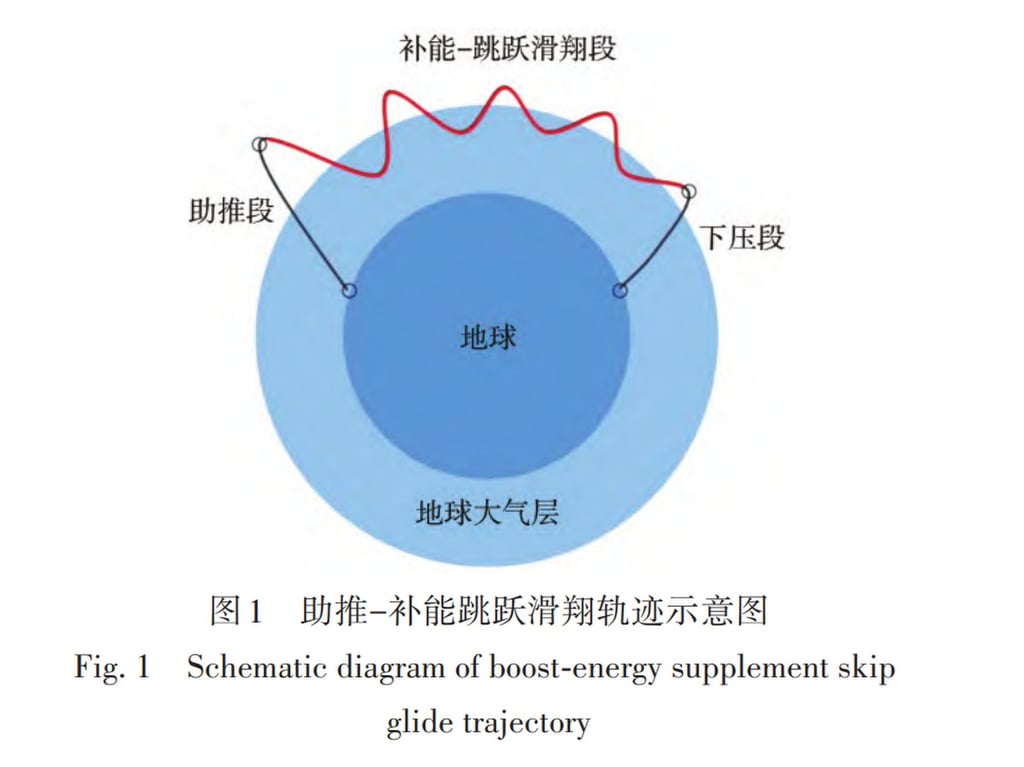China’s hypersonic weapons are poised for a significant upgrade, according to scientists involved in a project to develop a new type of hypersonic glide vehicle (HGV).
Using a trajectory similar to a skipping stone, the hypersonic glide vehicle can dive into and jump out of the atmosphere repeatedly at speeds exceeding Mach 15, thanks to a new solid-fuel booster capable of multiple ignitions.
A hypersonic glide vehicle is a type of warhead that can manoeuvre and glide at hypersonic speed to control a missile’s trajectory after launch.
By using the skipping stone trajectory, a missile’s kill range can be increased by more than one-third, extending the primary use of the hypersonic gliders from regional conflict to global operation.
This new generation of hypersonic weapons “possesses significant advantages in [military] application, featuring long range, high manoeuvrability and unpredictability”, the team led by Yong Enmi, a researcher with the China Aerodynamics Research and Development Centre, wrote in a peer-reviewed paper published in the Chinese Journal of Astronautics in June.
Through their research, the young scientists – the average age of those in Yong’s team is around 30 – are trying to surpass the dreams of Qian Xuesen.
Known as the father of Chinese rockets, Qian first proposed the concept of hypersonic gliders back in the late 1940s. The idea is that a glider is carried by rocket above the Earth’s atmosphere, and then it descends without power.
With the lift generated by its wings, it can fly thousands of kilometres within the atmosphere at speeds above Mach 7.
This non-ballistic flight is known as the Qian Xuesen trajectory. Currently, all known hypersonic glide weapons equipped in the military, such as China’s DF-17 missile, are designed based on this principle.
These hypersonic gliders can penetrate air defence systems with unparalleled speed and manoeuvrability.
According to war games recently disclosed by the Chinese military, these weapons could be launched from the Gobi Desert and effectively destroy US aircraft carrier fleets and military bases in the South China Sea.

But a more radical trajectory was proposed in 1941 by Eugen Sänger, an Austrian scientist working for Germany during World War II.
His Silbervogel (silver bird) aircraft was designed with a booster engine, allowing it to move in the upper atmosphere like a skipping stone.
This jump-glide flight path, or the Sänger trajectory, can increase the range and manoeuvrability of hypersonic weapons.
Sänger believed that the Silbervogel could be launched from Germany, drop bombs in New York, and land on Pacific islands controlled by Japan.
But his proposal has remained only on paper – until now.
“Many key technologies related to the development of aircraft with this trajectory are not solved and have not yet reached the technical maturity for engineering applications,” Yong and her colleagues wrote.
Boost-glide aircraft are larger and heavier than unpowered gliders. The multiple start-stop operations of solid-fuel engines are more challenging than liquid-fuel rockets. The optimisation of the Sänger trajectory is also much more complex than the Qian Xuesen trajectory.
Due to military sensitivity, previously published related research in China was limited to pure theoretical models.

But one glider design in particular has stood out with close links to practical applications, according to Yong’s team.
This aircraft features a slender body with fuselage integrated with wings. The trailing edge of the side wings has elevators, while the rudder is located on the wing’s raised tip.
“This layout has been verified through numerical simulations and wind tunnel test data and has been extensively used in the stages of optimisation design and model selection,” Yong’s team wrote.
Based on this new aircraft, they used a novel algorithm to optimise the Sänger trajectory. Computer simulations show that the aircraft’s top speed approaches Mach 20 and can maintain a speed above Mach 17 for more than half an hour by jumping repeatedly above the atmosphere.
After flying continuously for more than an hour, the aircraft can still glide at a speed above Mach 7. This means it can strike almost any location on the planet.
The gentler descent also reduces friction with the atmosphere. Compared to unpowered gliding, the maximum heat flux experienced by the new aircraft is expected to be reduced by half, which is beneficial for reducing the burden on the thermal protection system.
Yong’s team said the current technology still does not fully meet the requirements for actual combat.
The military demands that the aircraft be able to flexibly change its trajectory to bypass specific territorial air space. This requires additional auxiliary equipment such as reaction control systems.
The combination of multiple active and passive steering methods will pose unprecedented challenges to flight control, according to the researchers.
China is currently conducting extensive testing of related technologies.
According to public reports, the development of solid-fuel pulse engines capable of multiple ignitions has been completed.
The Sänger trajectory has been used to decelerate return capsules with speeds exceeding Mach 30 during multiple lunar sample return missions, all of which have been successful.
In 2021, China conducted a test flight of a hypersonic glide aircraft capable of going around the Earth.
This capability left US government scientists bewildered, according to a Financial Times report.
China’s achievement appeared “to defy the laws of physics”, an anonymous source was quoted as saying.



